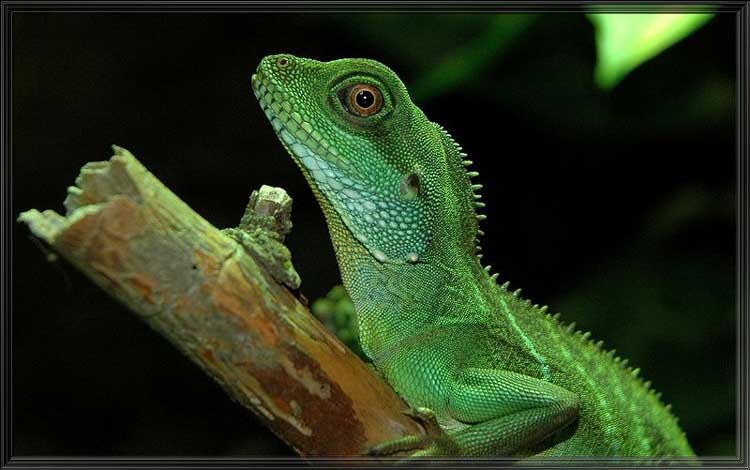
Physignathus cocincinus (*)
Superregnum: Eukaryota
Regnum: Animalia
Subregnum: Eumetazoa
Cladus: Bilateria
Cladus: Nephrozoa
Superphylum: Deuterostomia
Phylum: Chordata
Subphylum: Vertebrata
Infraphylum: Gnathostomata
Megaclassis: Osteichthyes
Superclassis: Sarcopterygii
Superclassis: Tetrapoda
Cladus: Reptiliomorpha
Cladus: Amniota
Classis: Reptilia
Cladus: Eureptilia
Cladus: Romeriida
Subclassis: Diapsida
Cladus: Sauria
Infraclassis: Lepidosauromorpha
Superordo: Lepidosauria
Ordo: Squamata
Cladus: Unidentata Episquamata Toxicofera
Subordo: Iguania
Infraordo: Acrodonta
Familia: Agamidae
Subfamilia: Amphibolurinae
Genus: Physignathus
Species: Physignathus cocincinus
Name
Physignathus cocincinus Cuvier, 1829
Vernacular names
dansk: Grøn vandagame
Deutsch: Grüne Wasseragame
English: Chinese Water Dragon
magyar: Ázsiai víziagáma, zöld víziagáma
日本語: インドシナウォータードラゴン
Nederlands: Chinese wateragame
polski: agama błotna
svenska: Grön vattenagam
ไทย: ตะกอง, ลั้ง, กิ้งก่ายักษ์
The Chinese water dragon (Physignathus cocincinus) is a species of agamid lizard native to China and mainland Southeast Asia.[1] It is also known as the Asian water dragon, Thai water dragon, and green water dragon. The genus name is Greek for "inflated jaw".
Description
Chinese water dragons can grow up to 36" (0.9m) in total length, including tail, and can live from 10 to 15 years.[2]
Coloration ranges from dark to light green, or sometimes purple with an orange stomach. Diagonal stripes of green or turquoise are found on the body, while the tail is banded from the middle to the end with green and white. Their undersides range from white, off white, very pale green, or pale yellow. But their throats are considered to be more attractive, which can be quite colorful (blue and purple, or peach), some with a single color, some with stripes. Adult males have larger, more triangular heads than females, and develop larger crests on the head, neck and tail, and are larger in general. The tail, slightly over two-thirds of the entire body length, can be used as a weapon, for balance, and to assist swimming.[3]
Like many other reptiles the Chinese water dragon possesses a small, iridescent, photosensitive spot between their eyes referred to as the pineal eye (or parietal eye, or colloquially as the third eye) that is thought to help thermoregulate their bodies by sensing differences in light to assist with basking and seeking shelter after sunset.[4] Since it recognizes differences in light, the parietal eye can also help the lizard avoid predation from birds and other aerial threats, and can awaken from deep sleep from even slight changes in light from overhead. These animals are very docile and allow physical activity.
Habitat and behaviors
Native to the lowland and highland forests of southern China and southeastern Asia (Thailand, Vietnam, Laos, Cambodia and Burma), Chinese water dragons are most commonly found along the banks of freshwater lakes and streams.[3] Water dragons live in areas with average humidity levels of 40–80% and temperatures ranging from 80–90 °F (26–32 °C).
They are active during the day (diurnal), and spend most of their time in the trees or plants (arboreal). If threatened, the dragon will drop from the trees into the water and either swim to safety or remain submerged for up to 90 minutes.
Diet
Though they will also eat vegetation, the diet of the water dragon consists mainly of insects, supplemented with an occasional small fish, mammal or reptile.
Reproduction
Chinese water dragons normally reproduce sexually, but sometimes reproduce by parthenogenesis instead.[5]
Invasive species
Chinese water dragons have established themselves in Hong Kong, probably from released pet animals.[6]
References
"Chinese Water Dragon (Physignathus cocincinus)". iNaturalist. Retrieved 2022-01-18.
Healey, Mariah. "Chinese Water Dragon Care Sheet". ReptiFiles. Archived from the original on 2022-01-18. Retrieved 2022-01-18.
"Chinese Water Dragon". World Association of Zoos and Aquariums. Archived from the original on 3 January 2015. Retrieved 18 August 2012.
"Reptiles & Amphibians Facts Sheets: Chinese Water Dragon". National Zoological Park. Archived from the original on 2008-10-07. Retrieved 2008-10-22.
Contributors, Ars (Dec 26, 2020). "Parthenogenesis: How females from some species can reproduce without males". Ars Technica. Retrieved Jan 10, 2021.
To, Allen (2005). "Another alien has landed: the discovery of a wild population of water dragon, Physignathus cocincinus, in Hong Kong" (PDF). Porcupine. 33 (November): 3–4.
Retrieved from "http://en.wikipedia.org/"
All text is available under the terms of the GNU Free Documentation License

